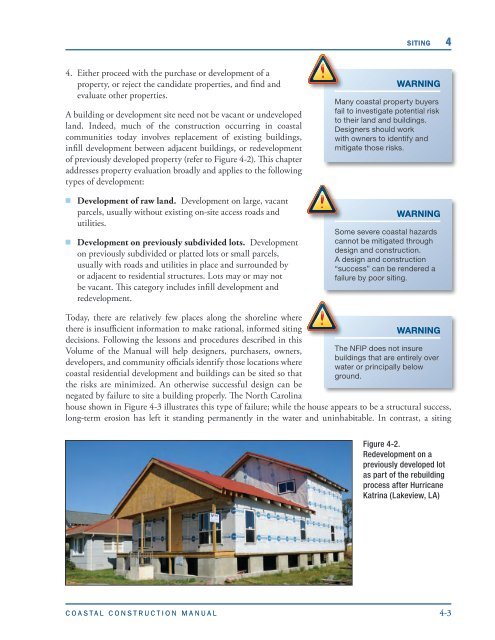Coastal Construction Manual - National Ready Mixed Concrete ...
Coastal Construction Manual - National Ready Mixed Concrete ...
Coastal Construction Manual - National Ready Mixed Concrete ...
Create successful ePaper yourself
Turn your PDF publications into a flip-book with our unique Google optimized e-Paper software.
SITING 4<br />
4. Either proceed with the purchase or development of a<br />
property, or reject the candidate properties, and find and<br />
evaluate other properties.<br />
A building or development site need not be vacant or undeveloped<br />
land. Indeed, much of the construction occurring in coastal<br />
communities today involves replacement of existing buildings,<br />
infill development between adjacent buildings, or redevelopment<br />
of previously developed property (refer to Figure 4-2). This chapter<br />
addresses property evaluation broadly and applies to the following<br />
types of development:<br />
<br />
Development of raw land. Development on large, vacant<br />
parcels, usually without existing on-site access roads and<br />
utilities.<br />
<br />
Development on previously subdivided lots. Development<br />
on previously subdivided or platted lots or small parcels,<br />
usually with roads and utilities in place and surrounded by<br />
or adjacent to residential structures. Lots may or may not<br />
be vacant. This category includes infill development and<br />
redevelopment.<br />
WARNING<br />
Many coastal property buyers<br />
fail to investigate potential risk<br />
to their land and buildings.<br />
Designers should work<br />
with owners to identify and<br />
mitigate those risks.<br />
WARNING<br />
Some severe coastal hazards<br />
cannot be mitigated through<br />
design and construction.<br />
A design and construction<br />
“success” can be rendered a<br />
failure by poor siting.<br />
Today, there are relatively few places along the shoreline where<br />
there is insufficient information to make rational, informed siting<br />
decisions. Following the lessons and procedures described in this<br />
Volume of the <strong>Manual</strong> will help designers, purchasers, owners,<br />
developers, and community officials identify those locations where<br />
coastal residential development and buildings can be sited so that<br />
the risks are minimized. An otherwise successful design can be<br />
negated by failure to site a building properly. The North Carolina<br />
WARNING<br />
The NFIP does not insure<br />
buildings that are entirely over<br />
water or principally below<br />
ground.<br />
house shown in Figure 4-3 illustrates this type of failure; while the house appears to be a structural success,<br />
long-term erosion has left it standing permanently in the water and uninhabitable. In contrast, a siting<br />
Figure 4‐2.<br />
Redevelopment on a<br />
previously developed lot<br />
as part of the rebuilding<br />
process after Hurricane<br />
Katrina (Lakeview, LA)<br />
COASTAL CONSTRUCTION MANUAL<br />
4-3







